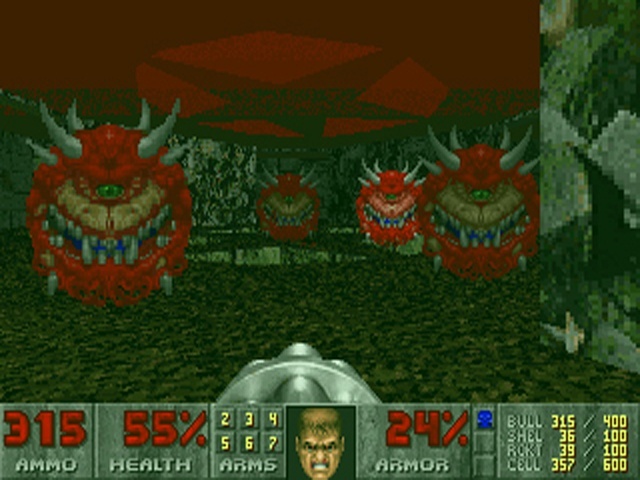Doom (1993) (PC) Review
By Athanasios  05.05.2016
05.05.2016

Shotguns and demons; that's what Doom is all about, and although this concept sounds silly and unimaginative, it's actually one of the key ingredients of one of the few true video game legends - but why exactly? Sure, this made the FPS genre popular, and was the unquestionable technical marvel of its time, but the same can be said about the Nazi-kill-a-thon, Wolfenstein 3D. Therefore, the question at hand is this: what did id Software's magnificent classic do that its predecessor didn't? Shortly before the release of the reboot of the franchise on 13th May, Cubed3 enters the inter-dimensional portal that leads straight to hell, and gets ready to experience it all again.
While most parents went bonkers when Mortal Kombat II got released back in 1993, a far more controversial title - Wolfenstein 3D - has been around since 1992. Why controversial, though? It was all about killing Nazis by the dozen, sure, but it had a somewhat cartoony look… and it was all about killing Nazis by the dozen! The "problem" was that everything was viewed from the eyes of the protagonist; the eyes of the player. Back then, this made everything ten times more immersive, deeply engaging, and… disturbingly real - and then came Doom, and all hell broke loose.
Before the advent of the SJW, self-important, "I want trigger warnings EVERYWHERE" nerd-prune of today, the late '80s were all about "them" against "us;" "them" being everyone who couldn't - or didn't want to - understand video games, with "us" being the ones with the capacity to grasp the notion of guilty pleasure… and id Software's new creation was the digital embodiment of that attitude. Think killing goose-stepping morons was a touchy concept? Get a load of a world inhabited by alien monsters with a thing for Satanism, served along some good ol' shredding tunes… a puritan's nightmare.
The plot? Not important. The protagonist? Not, either. Doomguy, our generic space marine, is the archetype of the tabula rasa-like avatar, and like Metroid and Castlevania, this was an example of experiential storytelling, with the player "living" the story, instead of merely being exposed to it. Naturally, the element that made it so immersive (besides the first-person perspective) were its fantastic visuals, which, similar to a Heavy Metal magazine cover, were as corny as they were awesome… and badass - oh, how badass they were.

It may be hard to believe it, but this heavily-pixelated homage to classic action and horror films was, for a long time, as next-gen as a video game could be. Despite its age, however, it still looks great. Unlike the bright and colourful VGA palette of Wolfenstein 3D, all textures have a realistic, almost gritty feel to them, whether that's a simple brick wall, or a marble surface decorated with a devilish visage. Furthermore, the varied brightness levels really bring these claustrophobic corridors to life, with flickering or oscillating lights, or even pitch-black darkness.
With films like Alien being obvious key-influences, the main theme of the franchise has always been an H. R. Giger-esque, unholy matrimony of flesh and machine, and, like many great games before it, the level design is abstract instead of realistic, and striking instead of mundane. As for the enemies, they look awesome, have amazingly detailed and gruesome death animations, and, since they are actually photographed sculpts, they have an almost life-like feel to them. A motley crew of undead and demons that has become almost as iconic as the Goombas of Super Mario Bros.
The looks are only part of the equation, with sound completing the package in the best way possible. Besides a classic MIDI (remember MIDI?) soundtrack, inspired - and slightly ripped-off - by metal legends like Black Sabbath, Metallica, Megadeth, and Judas Priest, amongst others, as well as some slower, mood-enhancing ambient tunes as a cherry on top, all sound effects, from the powerful weapon blasts, to the screeches and growls of alarmed foes, were simply perfect - and wait to hear the echoing roar of the towering Cyberdemon; the mating call of a carnivorous infernal bull on steroids!

There is a shooter here, though, isn't there? Well, there is, and it's surprisingly good, despite a certain thing that makes its age pretty clear. What's that? Our hero can't mouse-look, which means, first, that there's no way to look up or down, and, second, that in order to hit a monster, the gun's "centre" must be roughly aligned with it. The thing is, though, that while this is definitely a mechanic that belongs to the past, it provides a wonderful, almost arcade-y simplicity to everything - and the flawless controls make it all even better.
There's no regenerative health, no guidance as to where to go next, no scripted AI, and no specific cover system besides, well… hiding behind something. It's all about running around, shooting down demon after demon, collecting useful power-ups, and trying to find "that blasted red keycard" in order to proceed further down the intricate labyrinths; Doom is fast, it's relentless, it's raw! Many, however, have criticised it for having the dumbest enemies imaginable - an argument that couldn't be more valid, since all they do when they see the protagonist, is run/walk/fly towards him, and hit him with everything they've got.
Yes, the action is fast, and yes, the weapon variety is awesome, with not a single one ever becoming obsolete, since they all have their pros and cons, but all these can't erase the fact that all available foes are simpletons. Put anyone on an open field, and the fun factor decreases tenfold. Taking that into account, how can this be an entertaining experience? Simple. The best thing here has nothing to do with the fast-paced, run-and-gun gameplay. Instead, the genius of Doom, and the part where it truly shines is none other than its level design.

A frequent misunderstanding about the early Doom titles is that they were all about shooting down enemy wave after enemy wave, which couldn't be further from the truth. This is not Serious Sam. Instead, all levels are complex mazes full of traps, clever enemy placement, tons of secrets, and lots of risk/reward situations, where approaching a weapon in the centre of an empty room will open up hidden areas where more demons will come out from.
The key word when it comes to great level design is "balance." The enemy count is high, but not so much that gunfights get repetitive; the traps are aplenty, but they leave enough room for the player to react and deal with them; ammunition is finite, but enough to do the deed, and, finally, while part of the fun is trying to find a key to unlock a door, or a switch to lower a lift, this is handled in such a way that it never feels boring - mainly since each time a key is collected, some areas will get repopulated.
The 24-plus-three-secret-levels of adrenaline-pumping action are more than enough to have a good time with Doom, but there are two additional reasons for its high replay value. First of all, remember the term "Deathmatch?" Well, guess what made it famous? Yes, this might not be as refined as the arena-based shooters of today, but it can still be very entertaining. The second, and final, reason is that this is extremely mod-friendly, which resulted in literary thousands of mods, ranging from simple custom-made levels, to game-changers like the popular Brutal Doom, which is so good, that it actually influenced the upcoming reboot of the series - hopefully for the better.

Cubed3 Rating
Masterpiece - Platinum Award

Many believe that Doom is just a relic of the past; an important relic, sure, but nothing more than that. False! Id Software's creation isn't just a pioneer, but also one of the best video games ever made; a work of genius from a company whose mentality was, pretty much, quite similar to that of the indie developers of today: a game by gamers for gamers. It's good-looking, it has a kickass OST, it's fast, it's deeply engrossing, it's untinged by guilt, it's awesome… it's Doom, and it's here to stay until hell freezes over *crosses fingers*

![]() 10/10
10/10
![]() 0
(0 Votes)
0
(0 Votes)
 Out now
Out now  Out now
Out now  Out now
Out now  Out now
Out now Comments
Comments are currently disabled

 Sign In
Sign In Game Details
Game Details Subscribe to this topic
Subscribe to this topic Features
Features







 Top
Top

